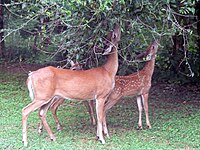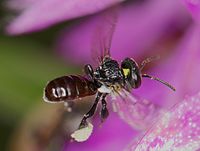
A model of wild bee populations accounting for spatial heterogeneity and climate‐induced temporal variability of food resources at the landscape level
Sign Up to like & getrecommendations! Published in 2022 at "Ecology and Evolution"
DOI: 10.1002/ece3.9014
Abstract: Abstract The viability of wild bee populations and the pollination services that they provide are driven by the availability of food resources during their activity period and within the surroundings of their nesting sites. Changes… read more here.
Keywords: wild bee; food resources; model; bee populations ... See more keywords

Wild bee larval food composition in five European cities
Sign Up to like & getrecommendations! Published in 2022 at "Ecology"
DOI: 10.1002/ecy.3740
Abstract: Abstract Urbanization poses threats and opportunities for the biodiversity of wild bees. At the same time, cities can harbor diverse wild bee assemblages, partly due to the unique plant assemblages that provide resources. While bee… read more here.
Keywords: wild bee; ecology; larval food; data set ... See more keywords

High honeybee abundances reduce wild bee abundances on flowers in the city of Munich
Sign Up to like & getrecommendations! Published in 2021 at "Oecologia"
DOI: 10.1007/s00442-021-04862-6
Abstract: The increase in managed honeybees ( Apis mellifera ) in many European cities has unknown effects on the densities of wild bees through competition. To investigate this, we monitored honeybees and non-honeybees from 01 April… read more here.
Keywords: high honeybee; honeybee; city munich; wild bee ... See more keywords

Statistical evidence that honeybees competitively reduced wild bee abundance in the Munich Botanic Garden in 2020 compared to 2019
Sign Up to like & getrecommendations! Published in 2022 at "Oecologia"
DOI: 10.1007/s00442-022-05113-y
Abstract: In a commentary on our paper (Renner et al., Oecologia 195:825–831, 2021), Harder and Miksha lay out why they think that our finding of higher honeybee abundances reducing wild bee abundances in an urban botanical… read more here.
Keywords: honeybees competitively; competitively reduced; wild bee; statistical evidence ... See more keywords

Prolonged blooming season of flower plantings increases wild bee abundance and richness in agricultural landscapes
Sign Up to like & getrecommendations! Published in 2021 at "Biodiversity and Conservation"
DOI: 10.1007/s10531-021-02233-4
Abstract: Flower plantings can increase the abundance of bees and improve pollination services in the surrounding landscape. However, uncertainty remains as to whether flower plantings play a role in wild bee conservation. The aim of this… read more here.
Keywords: abundance; wild bee; richness; flower plantings ... See more keywords

Interactions of local habitat type, landscape composition and flower availability moderate wild bee communities
Sign Up to like & getrecommendations! Published in 2020 at "Landscape Ecology"
DOI: 10.1007/s10980-020-01096-4
Abstract: Landscape and local habitat traits moderate wild bee communities. However, whether landscape effects differ between local habitat types is largely unknown. We explored the way that wild bee communities in three distinct habitats are shaped… read more here.
Keywords: bee communities; landscape; wild bee; bee ... See more keywords

The threat of pesticide and disease co-exposure to managed and wild bee larvae
Sign Up to like & getrecommendations! Published in 2022 at "International Journal for Parasitology: Parasites and Wildlife"
DOI: 10.1016/j.ijppaw.2022.03.001
Abstract: Brood diseases and pesticides can reduce the survival of bee larvae, reduce bee populations, and negatively influence ecosystem biodiversity. However, major gaps persist in our knowledge regarding the routes and implications of co-exposure to these… read more here.
Keywords: wild bee; exposure; brood; pesticide ... See more keywords

Using physiology to better support wild bee conservation
Sign Up to like & getrecommendations! Published in 2023 at "Conservation Physiology"
DOI: 10.1093/conphys/coac076
Abstract: Abstract There is accumulating evidence that wild bees are experiencing a decline in terms of species diversity, abundance or distribution, which leads to major concerns about the sustainability of both pollination services and intrinsic biodiversity.… read more here.
Keywords: wild bee; conservation; bee conservation; physiology ... See more keywords

Assessing Wild Bee Biodiversity in Cranberry Agroenvironments: Influence of Natural Habitats.
Sign Up to like & getrecommendations! Published in 2017 at "Journal of economic entomology"
DOI: 10.1093/jee/tox173
Abstract: The conservation of bee populations for pollination in agricultural landscapes has attracted a lot of recent research interest, especially for crop industries undergoing expansion to meet increased production demands. In Canada, much growth has been… read more here.
Keywords: cranberry fields; cranberry; wild bee; natural habitat ... See more keywords

Deep Vein Thrombosis After a Wild Bee Sting
Sign Up to like & getrecommendations! Published in 2021 at "Journal of Pediatric Hematology/Oncology"
DOI: 10.1097/mph.0000000000002072
Abstract: Allergic reactions from insect bites are mostly observed with bee stings. Bee sting reactions can be classified into 3 main headings: local, systemic, and rare reactions. Vascular thrombosis is considered both in rare and systemic… read more here.
Keywords: deep vein; wild bee; bee sting; thrombosis ... See more keywords

Integrative population genetics and metagenomics reveals urbanization increases pathogen loads and decreases connectivity in a wild bee.
Sign Up to like & getrecommendations! Published in 2023 at "Global change biology"
DOI: 10.1111/gcb.16757
Abstract: As urbanization continues to increase, it is expected that two-thirds of the human population will reside in cities by 2050. Urbanization fragments and degrades natural landscapes, threatening wildlife including economically important species such as bees.… read more here.
Keywords: connectivity; wild bee; urbanization; population ... See more keywords